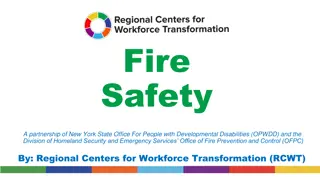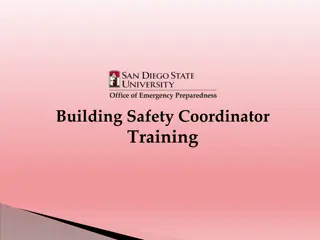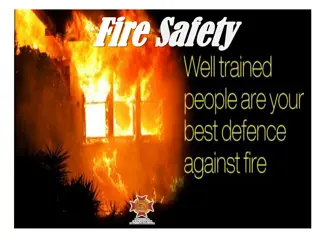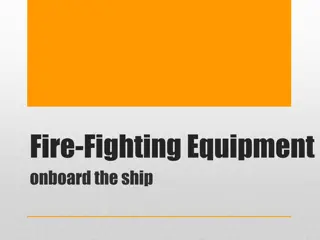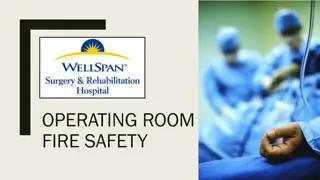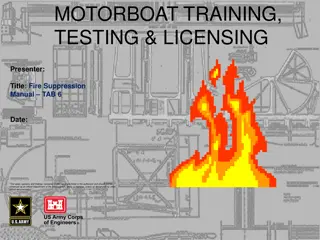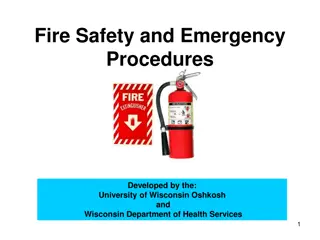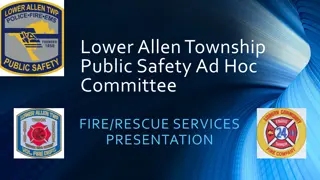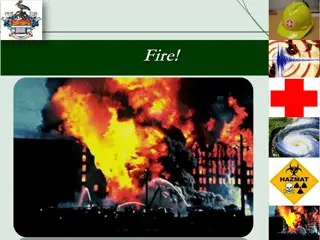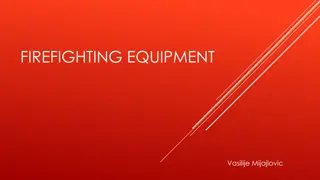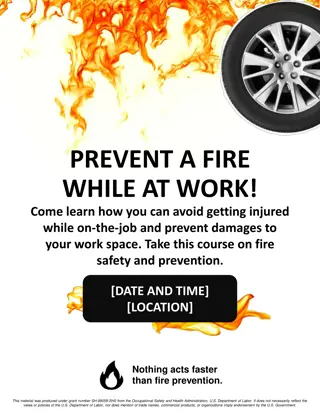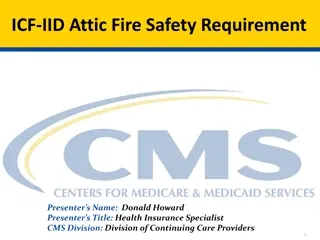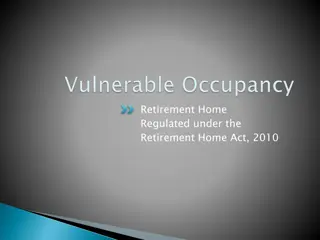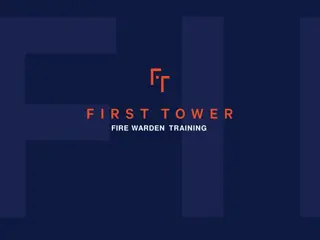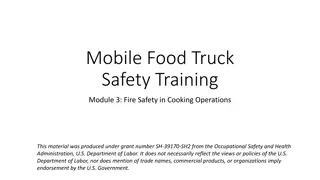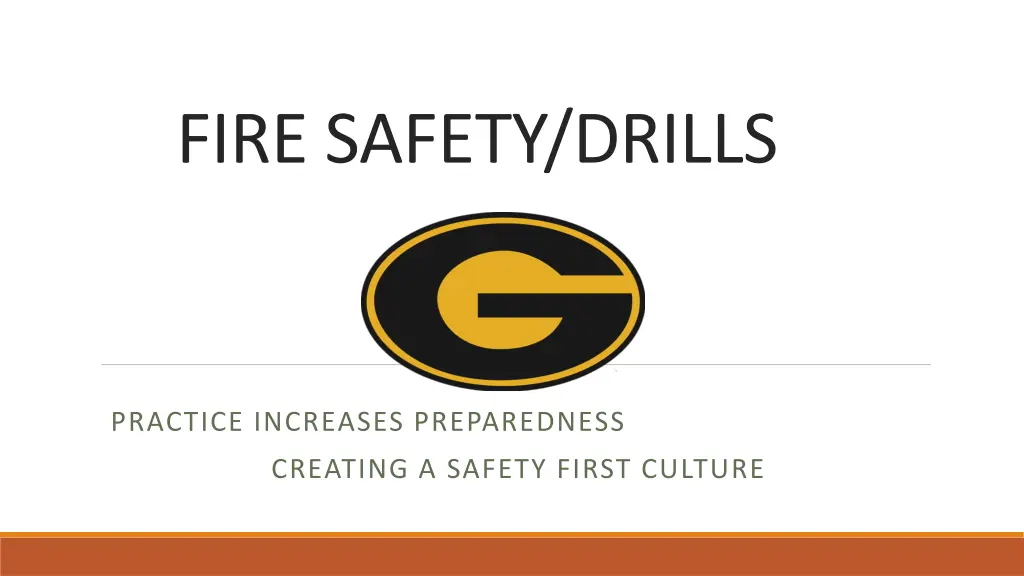
Campus Fire Safety and Prevention Practices
Learn about the importance of fire safety drills to increase preparedness and create a safety-first culture on campus. Understand common fire hazards such as smoking materials, candles, decorations, and arson. Discover why contacting university police first in case of a fire emergency is crucial. Explore the activation and location of fire alarms for effective fire prevention.
Download Presentation

Please find below an Image/Link to download the presentation.
The content on the website is provided AS IS for your information and personal use only. It may not be sold, licensed, or shared on other websites without obtaining consent from the author. If you encounter any issues during the download, it is possible that the publisher has removed the file from their server.
You are allowed to download the files provided on this website for personal or commercial use, subject to the condition that they are used lawfully. All files are the property of their respective owners.
The content on the website is provided AS IS for your information and personal use only. It may not be sold, licensed, or shared on other websites without obtaining consent from the author.
E N D
Presentation Transcript
FIRE SAFETY/DRILLS PRACTICE INCREASES PREPAREDNESS CREATING A SAFETY FIRST CULTURE
PURPOSE Fire Safety and Prevention is to educate participants on how to avoid fires and fire related injuries. create awareness of fire deaths and injuries and their common causes. inform participants of their personal responsibility toward fire safety and injury prevention.
Fire Hazards on Campus Smoking Material- Carelessness with cigarettes, matches, etc., accounts for the greatest number of residence hall fires. UNDER NO CIRCUMSTANCES IS SMOKING PERMITTED IN ANY UNIVERISTY BUILDINGS. Flame- Candles can be dangerous. Leaving them burning unattended or too close to combustible materials can lead to fires. Candles are not allowed in any residence hall. Decorations- Some decorations ignite easily and allow a fire to spread rapidly. These include holiday decorations, large posters, filmy curtains, and flammables tacked to the ceiling. Make sure all electrical devices, including lighting and extension cords are UL-approved Arson- Setting fires on purpose is the leading cause of campus fires. Arson is a serious crime that can result in unnecessary deaths.
Fire Hazards on Campus Cont. Appliances- Careless use of heat-producing appliances can start fires. RESIDENTIAL HOUSING oHot plates left on, unattended, or with grease build up on coils. oElectric blankets left on when resident is not in bed. oIrons left on, lying down, unattended, or used on a bed. oToaster ovens left on, with accumulated grease, or unattended. oHair dryers laid down while they are on or used to dry clothes. oPortable space heaters placed near combustibles like curtains or used to dry clothes. LABORATORIES AND OTHER AREAS Certain heating tools and equipment
Why do we contact GSU Police First If fire fighters are called out on a false alarm, they will not be available to fight a real fire. Contacting the GSU police first helps to prevent unnecessary calls to the Fire Department. WE UNDERSTAND that FALSE ALARMS create a mood of apathy so you may not react quickly enough to save your life if there is a real fire. However, as employees and students, we must actively respond and evacuate until clearance is given.
Activation of FIRE ALARMS Activation of the protective system shall occur by any or all of the following means but not limited thereto: oManual fire alarm initiation oAutomatic heat detection oAutomatic smoke detection oExtinguishing system operations
Location of FIRE ALARMS Each manual fire alarm station of a system shall be accessible, unobstructed, visible, and of the same general type. Audible alarm indicating devices shall be of such character and so distributed as to be effectively heard above the ambient noise level obtained under normal conditions of occupancy. The fire alarm and heat/smoke detection system shall be tested periodically and the results of the test recorded. The general evacuation alarm shall operate throughout the entire building.
RESPONSIBILITIES Each employee shall: oKnow where alarms are located and learn how to activate them. oAlert as many people in the building as possible and evacuate the building when you hear a fire alarm.
FIRE EXTINGUISHERS- GENERAL DESCRIPTION Fire extinguishers are designed to fight small fires. Find out where they are located and what kind of fires they are designed to fight. Do not block access to extinguishers. Report all extinguishers that are missing, damaged, or have been discharged. Do not empty fire extinguishers as a prank. Extinguishers mounted in cabinets, wall recesses, or brackets shall be placed in such a manner that the operating instructions shall face outward. Extinguishers shall not be obstructed or obscured from view, and cabinets housing extinguishers shall not be locked.
HOW TO USE EXTINGUISHER, rememberP A S S. Pull the pin. (Some may require pressing a puncture lever or releasing a lock hatch.) Aim the extinguisher nozzle or cone at the base of the fire. Squeeze or press the handle. Sweep from side to side at the base of the fire until it appears to be out.
EXIT AND MEANS OF EGRESS Identify exits Report any paths to exits that are blocked Use the stairs- NOT elevators Familiarize yourself with at least two exits for your location Do not cover/decorate exit doors Exit signs must be clearly identifiable
Grambling State University will conduct one fire drill at every employee/student occupied building once per year. FIRE DRILLS WHY: Fire and smoke drills are very important, especially in residence halls/classroom buildings. Knowing what to do in the event of a fire lessens the likeliness of panic. (Some drills may be held at night to practice escaping in the dark.) WHAT TO EXPECT: Fire drills will consist of a live drill in which building occupants must vacate a building to a safe haven in the same way that they would in the case of a fire. Take fire drills seriously; they may save your life. Follow directions of the person in charge.
WHAT TO DO IN CASE OF FIRE GSU Procedures
STEP 1. Stay calm. Think out what you have to do, then act because every second counts.
STEP 2. Sound alarm to warn others. Pull the alarm box. If there is none, shout and pound on doors as you evacuate. Never ignore an alarm. (In buildings equipped with smoke detector systems, the alarm will sound automatically if it doesn t, pull the alarm!)
STEP 3. Call 911 or GSU Police (318) 274-2222 Give full location clearly. Describe extent of fire. Answer any questions before you hang up.
STEP 4. If you are in your room when you hear an alarm, feel the door, If it is hot, don t open it. Stay in your room. If it is cool, open it a crack but be ready to slam it shut if you find smoke or flames. Leave if corridor seems safe.
STEP 5. If you can exit: Take your key and walk to nearest exit if there is no smoke. If there is smoke or if it is dark, crawl to exit, counting doors so you don t get lost. Close all doors behind you. Do not use elevators they are hazards in a fire. Use the stairs; hold on to rail. Turn back if you encounter heavy smoke (it is deadly) and look for another exit. Stand clear of the building and out of the way of the fire fighters when you get outside. Never go back into a burning building for any reason. Report to your meeting place.
STEP 6. If you are trapped in your room: Keep your door closed. Seal cracks around door with tape, clothes, sheets, etc. Open windows slightly, if there is no smoke outside. Open at top (to vent smoke) or at bottom (to let in fresh air). Tie wet cloth over nose and mouth to aid breathing. Stay low, where air is fresher (smoke rises). Signal rescuers by waving a sheet or clothing out the window, or telephone for help. Do not jump if you are higher than two stories.
STEP 7. If clothing catches fire Stop, Drop, and Roll! Do not run it will fan the flames. Drop to the floor and roll out fire. Drop and roll someone else on the ground. Use a rug, coat or blanket to smother flames. Cool the burn with cold water. Get prompt medical attention.
Thank you for viewing GSU Fire and Safety Training

